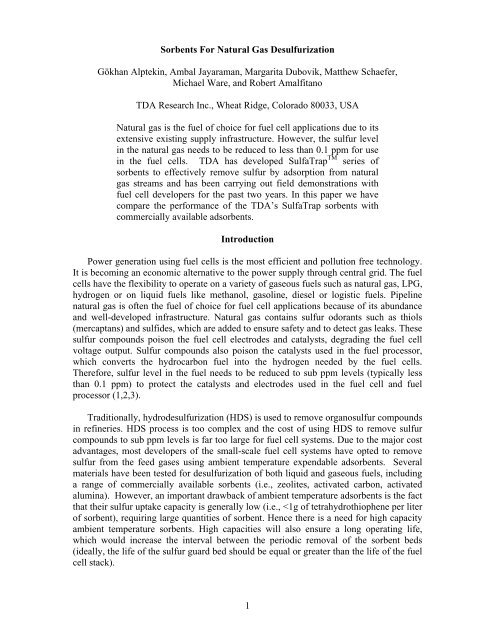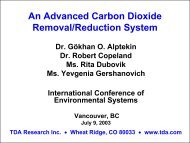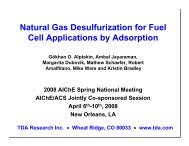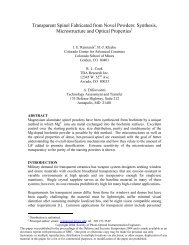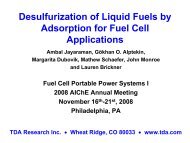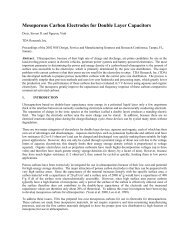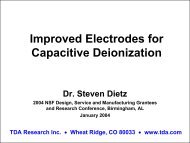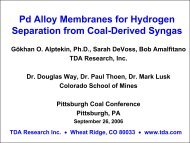Sorbents for Natural Gas Desulfurization - TDA Research, Inc.
Sorbents for Natural Gas Desulfurization - TDA Research, Inc.
Sorbents for Natural Gas Desulfurization - TDA Research, Inc.
Create successful ePaper yourself
Turn your PDF publications into a flip-book with our unique Google optimized e-Paper software.
1210DMS Concentration (ppmv)864Norit RGM3,ActivatedCarbonGrace XZeoliteCe Zeolite -YCu Zeolite XSulfaTrap TM200 100 200 300 400 500 600 700 800 900 1000Time (min)Figure 1. Comparison of <strong>TDA</strong>’s SulfaTrap TM sorbent with other adsorbents. All sampleswere tested at 60,000 h -1 in a natural gas mixture containing 12.3 ppmv DMS, 8.9 ppmvTBM and 8.9 ppmv THT at T= 20 o C, P= 5 psig.Table 1. Pre-breakthrough capacities calculated <strong>for</strong> the samples shown in Figure 1.SamplePre-BreakthroughCapacity (% wt. S)<strong>TDA</strong>’s SulfaTrap TM Sorbent 3.12%Grace X Zeolite 0.36%Norit RGM3 Activated Carbon 0.18%The breakthrough profiles of all sulfur species <strong>for</strong> <strong>TDA</strong>’s SulfaTrap - R3 sorbentare presented in Figure 2. In agreement with the prior literature, DMS breakthroughoccurred first at 720 minutes, followed by the breakthrough of TBM at 1080 minutes.The breakthrough of THT was never observed during 1400 minutes of testing. Theseresults suggest that the affinity of the sorbent is weakest <strong>for</strong> the DMS and strongest <strong>for</strong>the THT. The saturation sulfur capacity of the sorbent was calculated as 3.88% wt. (thesaturation capacity is the total sulfur loading of the sorbent measured when the DMSconcentration at exit of the bed was equal to its inlet value).In addition to the small-scale tests, we also tested the per<strong>for</strong>mance of a few samplesin large-scale (engineering-scale tests that can be easy to scale-up). In these tests, weused 25 cc of sample and a calibrated gas mixture containing synthetic natural gas, with50 ppmv water and 50 ppmv DMS. The DMS breakthrough profiles are shown in Figure3 <strong>for</strong> two of the samples and the test results are reported in Table 2. The first test wasdone on activated carbon (Norit RGM3 Activated Carbon), which is the current industrystandard. The second test was done with our SulfaTrap sorbent. Our sorbent greatlyoutper<strong>for</strong>med the activated carbon, with 3.2% wt. breakthrough capacity. Note that thesulfur adsorption capacity measured in the large-scale tests and small-scale acceleratedtests were in good agreement (3.2% wt. capacity vs. 3.12% wt., <strong>for</strong> <strong>TDA</strong> SulfaTrap TM -R3,and 0.18% vs. 0.13% <strong>for</strong> Norit RGM3).3
2520Breakthrough Capacity = 3.12% wt.Saturation Capacity = 3.88% wt.DMSConcentration, ppmv15105TBM00 200 400 600 800 1000 1200 1400 1600Run Time, minFigure 2. Breakthrough profiles of sulfur components from <strong>TDA</strong>’s SulfaTrap TM – R3sorbent. <strong>Natural</strong> gas with 12.3 ppmv DMS, 8.9 ppmv TBM and 8.9 ppmv THT at 60,000h -1 , T= 20 o C, P= 5 psig.Table 2. The sulfur adsorption capacities in large-scale tests.BreakthroughSampleCapacity(% wt. S)Norit RGM3 Activated Carbon 0.13%<strong>TDA</strong>'s SulfaTrap TM sorbent 3.20%DMS Concentration (ppmv)109876543210Norit RGM3Activated Carbon,<strong>TDA</strong>'s SulfaTrap TMsorbent0 2000 4000 6000 8000 10000Time (min)Figure 3. Comparison of breakthrough profiles <strong>for</strong> two samples tested in the large-scaleapparatus. Both samples were tested in a natural gas mixture with 50 ppmv water and 50ppmv DMS. The GHSV= 1,500 h -1 , T=20 o C, P= 50 psig.4
Effect of MoistureThe presence of water reduced the sulfur adsorption capacity of all sorbents. Thecapacity of the zeolite-X is reduced the most by approximately 83%, showing zeolite-X’shigh affinity <strong>for</strong> the water vapor. The water most likely adsorbs on the surface of thesites, competing with the sulfur. It is worth noting that Yang and his coworkers saw asimilar reduction <strong>for</strong> copper exchanged Y zeolite, which lost 75% of its breakthroughcapacity in the presence of 300 ppmw H 2 O (4). Activated carbon had minimal drop incapacity in the presence of water, but its dry capacity was an order of magnitude lowercapacity than <strong>TDA</strong>’s SulfaTrap TM -R3. As shown in Table 3, the capacity of theSulfaTrap TM -R3 sample is also reduced in the presence of 50 ppmv water vapor.However, the competition with water vapor was less of a problem (only 24% dropcompared to 83% <strong>for</strong> commercial zeolite) <strong>for</strong> the SulfaTrap TM -R3 sorbent, and its drycapacity was approximately 800% better than that of zeolite X, and 1600% better thanactivated carbon.Table 3. Effect of moisture on various sorbents.SampleDryCapacityWetCapacityPercentCapacity Loss<strong>TDA</strong>’s SulfaTrap TM -R3 Sorbent 3.1% 2.4% 24%Grace X Zeolite 0.36% 0.06% 84%Norit RGM3 Activated Carbon 0.18% 0.17% 2.3%Concentration (ppmv)16014012010080604020050 ppmv H2O350 ppmv H2O1000 ppmv H2O0 100 200 300 400 500 600Time (min)Figure 4. The effect of moisture level on DMS adsorption in <strong>TDA</strong>’s SulfaTrap TM -R3Sorbent. T= 22 o C, P= 5 psig, <strong>Natural</strong> gas with 46 ppmv DMS at 60,000 h -1 .We analyzed the effect of increased levels of moisture on SulfaTrap TM -R3. FromFigure 4 we see that as the moisture content in the natural gas stream increases from 50 to350 ppmv the DMS breakthrough point does not change but the shape of thebreakthrough curve does change. The DMS wave front is sharp and the breakthroughcurve goes over the inlet DMS concentration of 46 ppmv. This “roll over“ is widely seenin the breakthrough curves of multicomponent feed mixtures and is a result ofcompetitive adsorption of water and DMS. Water adsorption wave front sweeps throughthe bed and it desorbs some of the adsorbed DMS giving rise to the roll over. As weincrease the moisture level further to 1000 ppmv the DMS breakthrough capacity dropsby 30%. The breakthrough capacities are reported in Table 4. This shows that moisture5
levels up to 350 ppmv has only minimal impact on the per<strong>for</strong>mance of SulfaTrap TM -R3<strong>for</strong> DMS removal.Table 4. The Effect of moisture level on DMS and mercaptan adsorption on<strong>TDA</strong>’s SulfaTrap TM -R3 Sorbent.Feed <strong>Gas</strong> mix Adsorbate H 2 O(ppmv)DMS (~46 ppmv) in<strong>Natural</strong> gasDimethyl(DMS)SulfideBreakthroughSulfur loading(wt%)50 1.75350 1.641046 1.27At very high moisture levels of 4000 ppm, SulfaTrap TM – R2 (another SulfaTrap TMSeries sorbent) per<strong>for</strong>ms better than SulfaTrap TM – R3. In fact sulfur removal capacity ofSulfaTrap TM- R2 does not change due to moisture levels. Fuel cell manufacturers oftenprefer a sorbent which is more robust and does not have appreciable changes in sulfurcapacity with fluctuations in moisture level which could some times reach as high as4000 ppmv H 2 O. Figure 5 shows the breakthrough of DMS in the presence of 4000 ppmvH 2 O on SulfaTrap TM – R2 and R3 <strong>for</strong> comparison.300250SulfaTrap-R2SulfaTrap-R3DMS Concn. (ppmv)2001501005000 50 100 150 200 250 300Time (min)Figure 5. Effect of 4000 ppmv H 2 O on the breakthrough of DMS on various sorbents.Inlet DMS = 50 ppmv. GHSV = 60,000 h -1 .Effect of TemperatureDepending on the geographic location and the season, the desulfurization system usedin residential units has to work over a wide range of temperatures. In the bench-scaletests, we evaluated the per<strong>for</strong>mance of the SulfaTrap TM sorbent at three differenttemperatures. To carry out the 0/5 o C test, the reactor was placed in a chiller to maintain alow and stable temperature. For the 40/45°C test, the reactor was heated using heat tapes.6
Figure 6 and Figure 7 shows the DMS breakthrough profiles in a dry and wet natural gasmixture respectively at the three temperatures.Table 5 and Table 6 lists the pre-breakthrough sulfur adsorption capacity at eachtemperature <strong>for</strong> dry and wet natural gas mixtures. It is observed that as the temperatureincreases, the sorbent capacity decreases (at 40/45 o C, the sulfur capacity of the sorbent isreduced by 35-40% in comparison to that can be achieved at 19/22 o C). Such temperaturedependence suggests that the removal of the sulfur compounds is purely based onphysical interactions. It is important to note that the SulfaTrap TM sorbent is fullyregenerable, and once the sorbent reaches its capacity all the sulfur-bearing odorants canbe driven off from the surface with a mild temperature swing by heating the bed to 300 o C.Previously, we demonstrated that the sorbent could maintain its sulfur adsorptioncapacity through many adsorption/regeneration cycles [5] by simple heating. Thus, theobserved decrease in the capacity at higher temperatures was expected.Table 5. Sulfur adsorption capacity as a function of temperature.Testing Run Time CapacityTemperature (min)5°C 830 3.59%19°C 720 3.12%40°C 237 1.02%Table 6. Sulfur adsorption capacity as a function of temperature <strong>for</strong> wetnatural gas.Testing Temperature Run Time (min) Capacity0°C 359 2.35%22°C 289 1.75%45°C 152 1.00%DMS Concentration (ppmv)32140°C 19°C 5°C00 200 400 600 800 1000Time (min)Figure 6. Effect of temperature on sorbent per<strong>for</strong>mance. <strong>TDA</strong>’s SulfaTrap sorbenttested in dry natural gas mixture with 12.9 ppmv DMS, 8.9 ppmv TBM and 8.9 ppmvTHT, P= 2 psig.7
Concentration (ppmv)40353025201510545 C22 C0 C00 100 200 300 400 500 600Time (min)Figure 7. Effect of temperature on sorbent per<strong>for</strong>mance <strong>for</strong> DMS removal in the presenceof moisture 50 ppm. GHSV = 60,000 h -1ConclusionsThis study shows <strong>TDA</strong>’s SulfaTrap TM has higher capacity <strong>for</strong> natural gasdesulfurization than commercial zeolites and carbon samples and also that watercompetes with odorants <strong>for</strong> adsorption sites and negatively impacts the per<strong>for</strong>mance of alldesulfurization sorbents. Commercial zeolites lose most of their capacity in the presenceof water while <strong>TDA</strong>’s SulfaTrap TM -R3 still has high sulfur capacity. At very highmoisture levels <strong>TDA</strong>’s SulfaTrap TM -R2 showed very good capacity. There is competitionbetween water and DMS <strong>for</strong> the adsorption sites in SulfaTrap TM – R3 and <strong>for</strong> the case ofSulfaTrap TM - R2 we observed that there is no competition between water and DMS <strong>for</strong>adsorption sites. The order of selectivity <strong>for</strong> odorants on SulfaTrap TM is THT > TBM >DMS.ACKNOWLEDGMENTSThis work was supported by Department of Energy (DOE).REFERENCES1. F.A. Uribe and T.A. Zawodzinski, “The Effect of Fuel Cell Impurities on PEMFuel Cell Per<strong>for</strong>mance,” in Proceedings of 200th meeting of ElectrochemicalSociety, San Francisco, CA, 2001.2. P. De Wild, T.G. Nyqvist, and F. De Bruijn, “The Removal of Sulfur-ContainingOdorants from <strong>Natural</strong> <strong>Gas</strong> <strong>for</strong> PEMFC,” in Proceedings of Fuel Cell Seminar,p227, Palm Springs, CA, 2002.3. G. Israelson, in Journal of Materials Engineering and Per<strong>for</strong>mance, 13, 282(2004).4. Y.W. Li, F.H. Yang, G.S. Qi, and R.T. Yang, in Catalysis Today 116, 512 (2006).8


